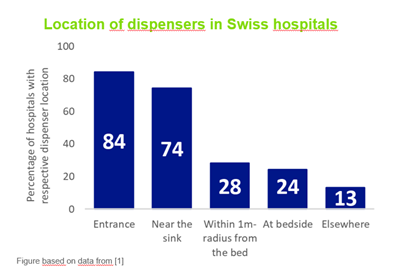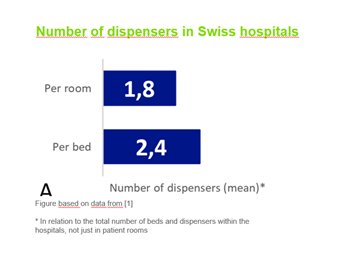Modes of Transmission

It is generally accepted that hand hygiene with alcohol-based hand disinfectants is the most effective measure for preventing healthcare-associated infections [1]. It is obvious that adequate hand hygiene for employees in health care facilities is only practicable if sufficient hand disinfectant dispensers are available at suitable locations. So far, however, only the German Robert Koch-Institute (RKI) has issued recommendations on the number of hand disinfectant dispensers and recommends at least one dispenser per bed in intensive care units or 0.5 per bed in normal wards. In contrast, neither the World Health Organisation (WHO) nor the American Centers for Disease Control and Prevention (CDC) nor the European Centre for Disease Prevention and Control (ECDC) have made such recommendations in their respective guidelines. In order to provide a basis for setting national and international minimum standards, a research group led by Professor Andreas Widmer of the SwissnosoNational Centre for Infection Prevention investigated the current number and locations of hand disinfectant dispensers in Swiss acute hospitals [1].
The study was based on a survey using an anonymised and standardised questionnaire (adapted from the PROHIBIT study), sent to all 178 hospitals in the Swissnoso Surveillance Network between July and September 2019. Certified infection control and hospital epidemiology specialists collected data on the number of dispensers per bed, the location of the dispensers and hand disinfectant consumption using electronic and paper-based tools. A total of 110 hospitals (62%) participated, providing information on the supply of about 20,000 acute care beds in Switzerland.
In most hospitals, hand disinfectant dispensers were found at the entrance to the room (n = 92, 84 %) and near the washbasin (n = 81, 74 %). In just under half of the hospitals, dispensers were available near or at the bedside. While wall dispensers dominated in three quarters of the participating hospitals, only a quarter mainly offered gown bottles. However, the latter were mostly additionally available in 97 % of the hospitals.

The survey of the total number of dispensers in the respective hospitals showed that Swiss hospitals are very well equipped, with an average of 2.4 hand disinfectant dispensers per patient bed. This number – based on intensive care and normal wards - is thus 2 to 4 times higher than the number recommended by the RKI for German hospitals. The study also showed that in large hospitals with more than 500 beds, the number of hand disinfectant dispensers correlated with hand disinfectant use. This could be an indication that the more dispensers available, the better hand hygiene is observed.

The results of the study have since been incorporated into the development of a Swiss minimum standard for equipping hospitals with hand disinfectant dispensers. In contrast to the RKI recommendation in Germany, however, this standard is mandatory and must be implemented by the clinics.
Sources:
1. World Health Organization (2009). WHO guidelines on hand hygiene in health care: first global patient safety challenge clean care is safer care.
2. Kuster S et al. (2021) Handrub dispensers per acute care hospital bed: a study to develop a new minimum standard. Antimicrob Resist Infect Control 10: 93. https://doi.org/10.1186/s13756-021-00949-0